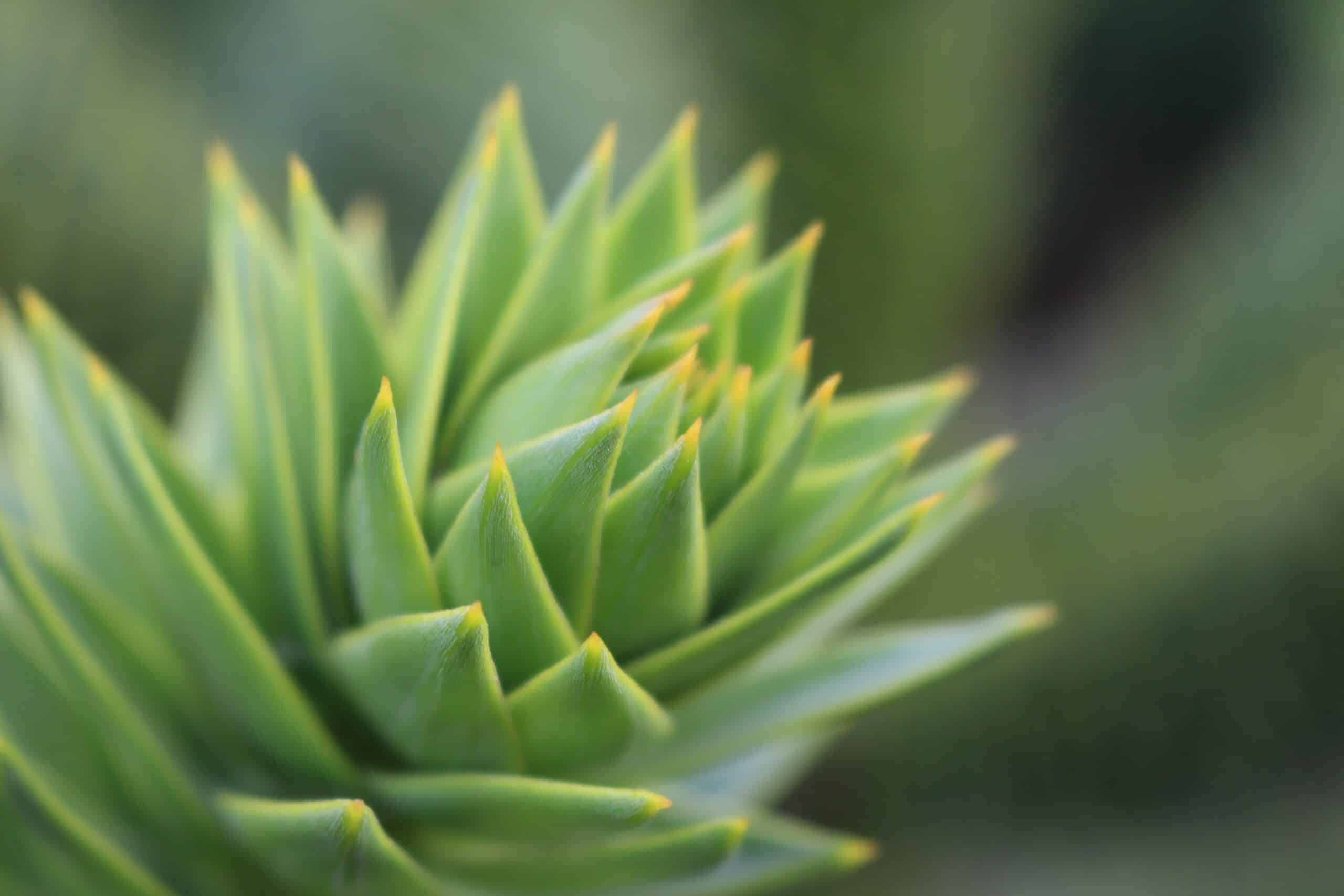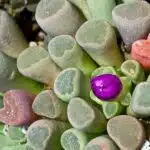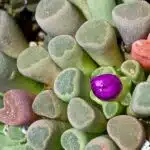Are you looking for a way to spruce up your home décor? Look no further than growing echeveria! With their bright colors and unique shapes, these succulents are sure to be a hit in any room of the house. Although they may seem intimidating at first, with some simple tips and tricks, even novice gardeners can have a thriving echeveria garden in no time. So don’t be scared – let’s dive right in and get growing!
The term “succulent” has become something of a buzzword lately, but what exactly is it? Succulents are plants with thick leaves or stems that store water in arid climates. This means that echeverias require very little maintenance and can survive even the harshest conditions. Despite their hardiness, there are still some specific tips and tricks to keep in mind when caring for echeveria plants – think of it as putting all your eggs in one basket! From finding the right type of soil to properly fertilizing your plants, following these guidelines will help ensure success for your budding garden.
So if you’re ready to take on the challenge of growing an echeveria succulent garden, read on! We’ll cover everything from choosing the perfect spot for planting to harvesting and propagating these beautiful plants. With just a little bit of effort and TLC, soon you’ll have an array of gorgeous succulents that will bring life into any room. Get ready to put green fingers to work and start building your dream garden today!
Choosing A Suitable Pot For Echeveria
Have you ever had an experience of wanting to get a particular plant but not knowing how to take care of it? That’s what happened to me when I decided to get an echeveria for my home. I wanted the beautiful succulent, but I was clueless about how to make it thrive. After researching on the internet, I came across some useful tips for getting started with growing echeveria.
The first step is selecting a suitable pot for the echeveria. It should have good drainage and be wide enough so that the plant’s roots can spread out and develop. Clay pots are ideal because they allow air circulation, but if you don’t have one available, plastic or metal containers will do as well. The important thing is to ensure that there are holes in the bottom so that any excess water can escape freely.
Having the right pot is just one part of creating a healthy environment for your echeveria; you also need to prepare the soil correctly. The soil should be sandy and gritty and must contain organic matter like compost or peat moss. You may also want to add some fertilizer if needed, since this will provide nutrients for your succulent as it grows. Making sure your soil is properly prepared before planting gives the best chance of success for your echeveria!
Preparing The Soil For Echeveria
Before you can feel the joy of watching your succulent flourish, there is one important step: preparing the soil for echeveria. It’s like building a foundation for a house – if it is done right, then you can expect a long-lasting structure that will stand the test of time.
With soil preparation, it’s all about balance. Your echeveria needs to be able to absorb water but not become soggy or overly saturated. A well-draining potting mix should include some combination of peat moss, sand, and perlite to ensure good drainage while still providing enough organic matter to retain moisture and nutrients. Additionally, adding a few handfuls of compost or an organic fertilizer with low nitrogen content will help your plant get off to a strong start.
Once you have found the perfect soil for your succulent, it’s time to start planting! Fill your pot with the soil mixture and gently lift your echeveria out of its container; this is best done by gripping the base of the stem close to the leaves and carefully pulling up. Place the plant in its new home and add more soil around it so that the root system is entirely covered. TIP: When transplanting an echeveria, make sure you leave at least one third of its body above ground level so it gets enough sunlight and air circulation!
Planting Echeveria
Planting echeveria is the third step in growing these beautiful succulents. It’s like the final piece of a puzzle, when you get to admire your masterpiece. So let’s dive into this last stage and see how we can make sure our plants have the best start possible.
When it comes to planting echeveria, think of it as a process of artfully arranging pieces that each has its own unique purpose. First, use a pot with ample drainage holes and add some coarse material such as gravel or pumice at the bottom. This will help ensure good aeration for the roots and prevent waterlogging. Then, fill up with soil-less potting mixture that contains extra grit or perlite for better drainage and aeration.
The next step is to carefully place your succulent into its new home. Make sure you leave enough space between each plant so they don’t overcrowd each other; also, if planting multiple varieties, mix them up so that different colors are displayed well! Finally, lightly press down on the soil around the base of each plant to ensure good contact with the roots.
Now that our echeveria have been safely tucked away in their new home, it’s time for us to focus on providing them with just the right amount of water – which is essential for their long-term health and growth!
Watering Echeveria
Watering echeveria is like walking a tightrope. You must be gentle and precise in order to maintain the delicate balance between “too much” and “too little.” Too much water can quickly cause root rot, while too little water will cause the leaves to become wrinkled and shriveled. So, it pays to take your time when you are watering your succulent.
When it comes to watering echeveria, the rule of thumb is that if the soil is dry an inch below the surface, it’s time for a drink. Pour enough water into the center of the rosette until you see some seeping out of the bottom drainage holes at the base. This ensures that all of the soil around the roots has been adequately saturated with moisture. Let any excess water drain away from the pot before returning it to its location.
For optimal growth, aim to water once every two weeks during spring and summer months when there is plenty of light available for photosynthesis. During autumn and winter months, cut back on watering as much as possible since this is a period of dormancy for these succulents. With proper care and attention, your echeveria should thrive under normal houseplant conditions in no time!
Fertilizing Echeveria
Fertilizing echeveria is an important part of caring for this succulent. For example, one of our customers, Sally, had a beautiful echeveria plant that was not growing as she wanted it to. After consulting with us, we determined that she needed to begin fertilizing her plant.
Giving your echeveria the nourishment it needs is essential for its growth and health. Fertilizing your succulents should be done every two weeks during the growing season with a balanced liquid fertilizer diluted to half strength. During the winter months, you should reduce the frequency of fertilizing and use only half strength fertilizer once every month or two.
It’s important to remember that too much fertilizer can burn your plant, so always start with a low-strength solution and increase gradually if needed. If you have any questions about how often and how much to fertilize your echeveria, consult a horticulturist or other expert in succulent care for advice tailored to your individual situation. With proper fertilization and care, your echeveria will thrive! Now let’s move on to providing light and temperature conditions that are ideal for these plants.
Providing Light And Temperature Conditions
Providing light and temperature conditions for your echeveria is essential to its growth. Just like any other plant, the right amount of light and a suitable temperature are important for an echeveria’s health. Additionally, there are some specific needs your succulent will have that are unique to its species.
When it comes to lighting, echeverias need plenty of direct sunlight in order to thrive. If you live in an area with hours of intense sunlight, you may need to provide some shade for your plant during the hottest parts of the day. On the other hand, if you have too much shade or not enough light, then you’ll need to supplement with artificial lighting.
Your echeveria also needs adequate temperatures that fall within certain parameters. Daytime temperatures should be between 65-75 degrees Fahrenheit (18-24°C), while nighttime temperatures should stay around 10°F (5°C) cooler than daytime temperatures. TIP: Make sure you monitor these conditions carefully; deviations from these ranges can cause damage or even death to your succulent!
Finally, controlling humidity levels is important for keeping your echeveria healthy and strong. The air around it should be dry and arid; otherwise, it could succumb to diseases or rot due to too much moisture in the air. Humidity levels should stay between 20%-40%. By following these guidelines and providing sufficient light, temperature and humidity levels, your echeveria will thrive!
Controlling Humidity
Keeping the humidity controlled is key for growing echeveria succulents. From the high desert to your own home, it’s essential to provide the right environment to ensure these resilient plants thrive. Here, we’ll explore how to manage humidity for successful echeveria growth.
For a start, it’s important to note that most succulents prefer a dry atmosphere and don’t want too much moisture. As such, it’s important not to mist them too often or place them in excessively humid conditions. Natural air flow is a great way to keep humidity at bay; open windows and doors when possible will circulate the air and help keep moisture levels low.
On the opposite end of the spectrum, particularly arid climates can be tough on succulents too; they need some minimal level of humidity to survive. A good rule of thumb is that if you’re comfortable in your home then so are your plants! Utilizing a humidifier near your echeveria can help boost their health – just make sure that you don’t overdo it. With simple adjustments like these, you can have healthy echeveria that grow happily in any environment!
Transplanting Echeveria
Transplanting echeveria is an important step in the succulent’s development and should not be overlooked. It’s necessary for the plant to grow in a healthy way and to ensure it lives a long life. When transplanting, make sure that you use a potting mix with excellent drainage capabilities, as this is essential for keeping your echeveria healthy. Additionally, you’ll want to find a pot that’s slightly larger than the original one so that the roots have more room to develop.
When transplanting your echeveria, it’s best to do so during its dormant period which typically lasts from late fall through early spring. This will give the plant time to adjust to its new environment before it begins actively growing again. After replanting, water your echeveria lightly; don’t drench it since too much water can cause root rot and other problems.
To ensure that your echeveria continues growing strong and healthy, keep an eye on the soil moisture levels by feeling the top layer of soil before watering each time. With proper care and attention, your newly transplanted echeveria will soon establish itself in its new home and thrive! To give it an extra boost of growth, next up we’ll discuss pruning and tending to your echeveria.
Pruning And Tending To Echeveria
It’s time to go beyond the basics of growing echeveria and get into more advanced techniques! We’ve already covered how to plant, water, and fertilize your echeveria—so now it’s time to talk about pruning and tending. Let’s dive in!
Pruning your echeveria is an important part of keeping them healthy and attractive. By removing dead or damaged leaves, you’ll be able to encourage new growth and maintain their shape. When pruning, make sure that you’re cutting close to the stem so that there are no stubs left behind. Also, try not to remove too much foliage at once—it can shock the plant.
Tending to your echeveria requires a bit more work than just pruning. You should also keep an eye on pests and diseases as they can quickly spread throughout the plant if left unchecked. Additionally, you should check for signs of over-watering or under-watering as these can lead to wilting or brown patches on the leaves. With regular maintenance, your echeveria will stay healthy and vibrant for years to come! TIP: Always use sterilized shears or scissors when pruning your echeveria plants in order to prevent any infection from spreading amongst them.
Controlling Pests And Diseases
Unfortunately, pests and diseases can be a problem for echeveria. But if you know how to identify these issues, you can take steps to prevent them from happening or address them when they do occur.
The most common pests that affect echeveria are mealybugs and aphids. They cause a white, waxy coating on the leaves of the plant and suck away its nutrients. To prevent infestations, it’s important to inspect new plants before bringing them home and avoid overcrowding the plants in your garden or containers. If an infestation does occur, you can treat it with insecticidal soap or neem oil.
Another issue that can affect echeveria is root rot, which is caused by overwatering. To prevent this problem, make sure that your pot has drainage holes so excess water can escape and always let the soil dry out between waterings. If root rot does become an issue, repotting the plant in fresh soil may help save it from further damage.
Taking preventive measures against pests and diseases is key to growing healthy succulents like echeveria. With proper care and attention, you should be able to keep your plants healthy and thriving! And with that in mind, let’s move onto propagating echeveria – another way to increase your succulent collection!
Propagating Echeveria
Propagating echeveria is like planting a new garden — it’s an exciting and rewarding process that allows you to watch your succulents grow and flourish. The process of propagating echeveria is surprisingly simple and can be a great way to expand your existing collection. To get the best results, there are a few key steps that must be followed.
The first step in propagating echeveria is to take healthy cuttings from an existing plant. You should make sure that the cutting has at least two or three leaves attached as these will provide the nutrients for the new plant to thrive. It’s important not to take too many cuttings from one plant as this could weaken it, so try to keep it below five. Once you have your cutting, you’ll need to allow the end of it to dry out before you can begin planting.
Once your cutting has air-dried, you can begin planting by adding soil or cactus mix into a pot and creating a small hole in the center before carefully inserting your cutting. Make sure not to press down on the soil too much as this could damage the roots of the new plant. Next, water lightly and allow some time for the cutting to settle into its new home before giving it any more water. Once planted, place in an area with indirect sunlight and temperatures between 50-80°F (10-28°C). Regularly check on your plants’ progress and adjust their care accordingly; for example, providing more light if needed or less water if necessary. With proper care, you’ll soon have beautiful echeveria growing in no time!
Having successfully propagated echeveria, now it’s time to give them some room to grow by repotting them into larger containers with fresh soil –– but that’s a story for another day!
Repotting Echeveria
Ah yes, the dreaded task of repotting – we’ve all been there at one point or another. You know, when you feel that your precious little echeveria is just begging to be rehoused in a larger pot with fresh soil? It’s an inevitable part of life if you’re a succulent enthusiast! But don’t worry – I’m here to guide you through this not-so-daunting chore.
The process of repotting echeveria is actually quite simple. All you need is a new pot that’s slightly bigger than the current one (make sure it has adequate drainage!), some good quality succulent soil, and your trusty echeveria. First, carefully remove the plant from its current container and loosen any tangled roots. Place it in the new pot and fill it with soil up to the base of the plant. Water thoroughly until water runs out of the drainage holes, and voila! Your echeveria will thank you for its luxurious upgrade.
Now if only all aspects of caring for plants were this easy! Sadly, there are many common issues that can arise with echeveria – but don’t fret! With proper care and attention, these beauties will thrive in their new home.
Common Issues With Echeveria
It’s often said that planting a garden is an act of faith. You put in the hard work and watch as nature takes its course – sometimes with success, sometimes not. Growing echeveria succulents is no different, and it’s important to know what issues you could potentially face along the way.
As we move onto our 13th step on growing echeveria, we’ll explore the common issues associated with these unique plants. While many will thrive with minimal effort, echeverias are prone to certain problems that can be frustrating for growers. From wilting to discoloration, knowing how to identify and address these issues ahead of time can make all the difference in your garden’s success.
Many times, when a plant is struggling it can be due to either over or under-watering. It’s essential to check soil moisture levels before watering again and only water when needed – this prevents root rot which can quickly kill off an echeveria if left untreated. Additionally, too much sunlight or improper light sources can cause leaves to yellow and eventually fall off, leaving the plant looking less than desirable. To avoid this issue, make sure you select a spot that offers filtered light so that your succulent has enough sun without becoming scorched by direct rays.
All in all, taking care of echeveria requires patience and observation as these succulents tend to need more attention than other plants. With proper troubleshooting tips and regular maintenance though, you’ll be well on your way to a thriving garden full of lush echeverias!
Troubleshooting Tips For Echeveria
As if you opened a book of secrets, troubleshooting tips for echeveria brings forth a wealth of knowledge to help you grow these amazing succulents. With the right information and understanding, you can discover the best way to care for your plants and keep them healthy and happy.
First and foremost, recognize that too much water is the number one cause of death among echeverias. Make sure the soil is well-draining to prevent waterlogging, and let the top layer of soil dry out completely before watering again. Also avoid direct sunlight or exposing them to temperatures that are too high or low—they’re happiest in bright, indirect light and warm temperatures between 60-70F (15-21C).
Mealybugs are another common problem with echeveria; they feed on plant juices and cause yellow spots on leaves. To get rid of mealybugs, try spraying your plant with a mixture of dish soap and water or rubbing alcohol solution. Additionally, fertilizing during growing seasons can help prevent nutrient deficiencies which can weaken your plants. Be sure to use a fertilizer specially formulated for succulents to ensure optimal growth without overfeeding your plants.
By following these simple tips, you’ll be well on your way to maintaining vibrant echeverias without any serious issues arising along the way! So take some time today to review these troubleshooting tips so you can enjoy beautiful succulents in no time.
Enjoying Echeveria
Growing beautiful echeveria is an especially rewarding experience for succulent enthusiasts; in fact, according to a survey of over 1000 gardeners, almost 90% of them reported feeling relaxed and inspired after tending to their echeveria plants. So now that you’ve learned the basic tips for growing this wonderful plant, it’s time to look at the last step: enjoying your echeveria.
There are several ways to truly appreciate the beauty of these succulents. Firstly, you can place a few potted echeveria plants on your windowsill or other sunny spot in your home or office – they’re sure to brighten up any room! Additionally, if you have outdoor space, you can create a stunning display by planting echeveria in rock gardens or containers. You could also craft unique living art pieces with different varieties and colors of echeveria clustered together.
Finally, don’t forget to take some time each day to observe and appreciate what your plants are doing. Watch how the light changes their color or shape throughout the day and study their growth patterns as they develop new leaves and branches. With just a little bit of love and attention, your echeverias will thrive – providing you with years of joy and beauty!
Frequently Asked Questions
What Is The Best Time Of Year To Repot Echeveria?
Repotting echeveria is a crucial step in caring for succulents and should be done at the right time of year. It’s almost like a seasonal dance with Mother Nature; you want to make sure you’re on-time. Picture it: the delicate leaves of an echeveria, swaying in delicate harmony with the warm summer breeze. Ahh!
The best time to repot echeveria is late spring or early summer. The warmer months are ideal for transitioning your plant into a bigger pot. This is because succulents tend to go dormant during winter, so they won’t require as much water or fertilizer during that season. Plus, they’ll have enough energy stored up to survive the repotting process and flourish in their new location.
Bear in mind that if your succulent has grown too large for its current container, it’s probably time to get it into something bigger! Repotting will give your plant more room for growth and ensure it stays healthy and strong for years to come. Follow these steps and you’ll have gorgeous blooms all season long!
How Often Should I Water Echeveria?
It’s easy to understand why so many people love echeveria: they’re low-maintenance and beautiful. But, if you want your succulent to thrive, you need to pay close attention to how often you water it. Coincidentally, this is the exact subject of this article: how often should you water echeveria?
Watering succulents can be confusing. On one hand, they don’t need a lot of water; on the other hand, too little can cause them harm. So what’s the best way to keep your echeveria healthy? Here are some tips for getting it just right:
• Water when the soil is dry for at least 1 inch deep. It’s important not to wait until the plant looks wilted before watering; by then it may already be too late. • Make sure the soil has completely drained after each watering session. Succulents hate soggy soil! • When in doubt, give it less water rather than more. Overwatering is a common mistake that can lead to root rot or other issues. • Avoid using tap water if you can; filtered or rainwater is preferable since it doesn’t contain as much salt and minerals as tap water does.
In short, good drainage and moderate amounts of filtered or rainwater are key when caring for echeveria—just remember that too much of either isn’t good! With these tips in mind, your succulent will stay happy and healthy!
How Can I Tell If My Echeveria Is Receiving Enough Light?
Having a gorgeous succulent like echeveria in your home is a great way to brighten up the atmosphere. But, if you want it to really flourish, you’ll need to make sure it’s getting enough light – that’s the key ingredient for success. It can be hard at times to tell if your echeveria is getting sufficient light and too much or too little can have serious consequences.
So, how do you know if your beloved succulent is sun-kissed enough? Well, there are a few signs of an echeveria being perfectly lit. Firstly, its leaves should be firm and upright rather than limp and drooping – that’s a good indicator that it’s not lacking in sunshine. Secondly, looking at the leaf color can be a helpful guide; if they’re vibrant and deep in hue then it means your echeveria is doing well in terms of lighting conditions. Conversely, when there are patches of pale green or yellow on the leaves this could mean that your plant isn’t receiving adequate light levels.
Ultimately, knowing whether your echeveria is being given enough light can be tricky but keeping these tips in mind should help you get a better understanding of its needs. Sunlight may be one of life’s greatest gifts but also one of the most finicky when it comes to plants; if you’re careful and attentive with yours then you’ll soon have a healthy and vibrant echeveria on your hands – like hitting the jackpot!
How Do I Know If Echeveria Needs To Be Fertilized?
It’s like a garden riddle—figuring out when and how to fertilize succulents such as Echeveria. Fertilizing, like other important care tips for succulents, is a delicate balance that requires a bit of trial and error. But don’t worry—with these steps, you can find the sweet spot for your own Echeverias in no time.
Just like a seedling needs sunshine to sprout, so too does an Echeveria need nutrients to grow strong and healthy. Fertilizer contains the vital minerals and nutrients that will give your Echeveria the boost it needs to thrive. When it comes time to feed your succulent, think of it as giving them their daily vitamins!
So how do you know when your beloved Echeverias need fertilizer? It’s simple—just observe them! Look out for signs of distress such as wilting or yellowing leaves, then pick up some fertilizer from your local nursery and get ready to feed your plants. As with most things in life, moderation is key – too little or too much fertilizer can do more harm than good, so start with small doses and increase gradually if needed. Like a lighthouse guiding sailors home on stormy seas, keep an eye on your Echeveria for any signs that indicate they need more nutrition.
Feeding your succulents right can be tricky business but with patience and dedication you’ll find the perfect balance between light, water and fertilizer they need to flourish. So step into the garden – armed with knowledge – and tend lovingly to those precious plants!
Is There A Way To Prevent Echeveria From Getting Pests?
Pests, such as mealybugs and aphids, can be a gardener’s worst nightmare. Like a silent intruder entering a home, they can sneak in and wreak havoc before you even realize it. It’s like an infestation: Once they’ve claimed their spot, they can spread quickly and cause considerable damage. Fortunately, there are some steps we can take to prevent pests from ever setting foot on our beloved echeveria.
One of the best ways to protect echeveria is to keep them healthy and stress-free. Consistent watering and pruning will encourage strong growth, while adequate drainage will help keep soil dry between waterings and reduce the risk of root rot. Additionally, it’s important to avoid overwatering since this can make plants more vulnerable to pests. Metaphorically speaking, healthy plants are like strong fortresses; when we give them the resources they need, we’re better equipped to ward off any unwanted visitors.
In addition to keeping your plants well cared for, regularly inspecting them for signs of pests is paramount. Look closely at leaves and stems for any white or brown spots that may indicate mealybugs or other insects have taken up residence or have been snacking on your plant. If you do notice any signs of pests, take action right away by removing them with cotton swabs dipped in rubbing alcohol or using insecticidal soap sprays.
TIP: To further deter unwelcome guests from invading your succulent garden, consider surrounding your echeveria with companion plants like basil or lavender which naturally repel insects.
Conclusion
Echeveria is a beautiful plant that can be the perfect addition to any home. With proper care and attention, these succulents can live for many years. Knowing when to repot, how much water to give, and making sure the plant receives enough light are all important considerations when caring for Echeveria. Additionally, it is important to watch out for pests and fertilize as needed.
Overall, caring for Echeveria may seem like a daunting task at first but with some patience and effort you will be rewarded with a stunning plant that will bring joy into your home. It’s definitely worth taking the time to learn more about how best to care for this wonderful succulent so you can get the most out of it!
Caring for Echeveria is an enjoyable experience that brings peace and beauty into our lives. With just a bit of TLC, you’ll find yourself surrounded by lush green foliage and gorgeous blooms. So don’t delay – if you’re ready to add this magnificent plant into your life then start researching today!





























